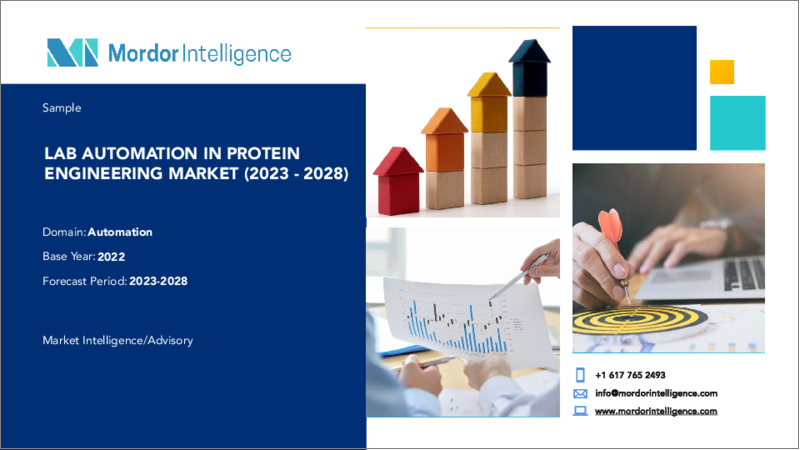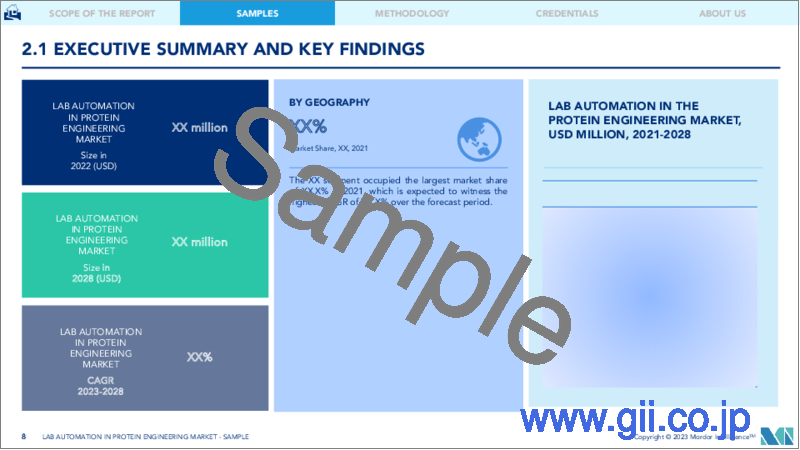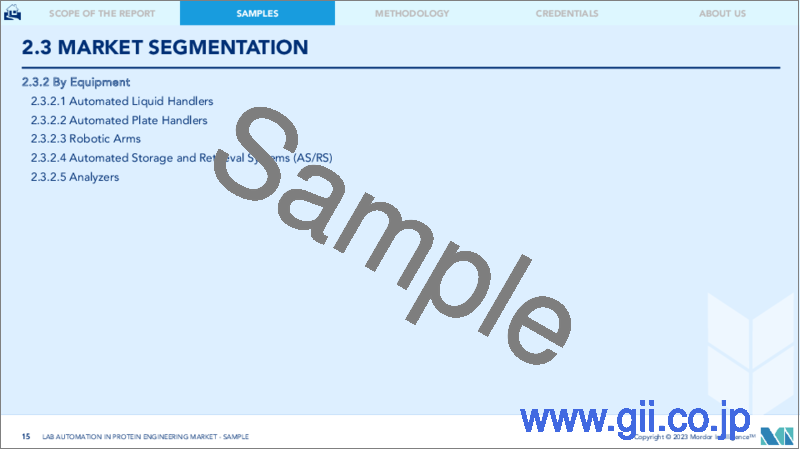|
|
市場調査レポート
商品コード
1197369
プロテインエンジニアリング向けラボラトリーオートメーション市場 - 成長、動向、予測(2023年-2028年)Lab Automation In Protein Engineering Market - Growth, Trends, and Forecasts (2023 - 2028) |
||||||
|
● お客様のご希望に応じて、既存データの加工や未掲載情報(例:国別セグメント)の追加などの対応が可能です。 詳細はお問い合わせください。 |
|||||||
| プロテインエンジニアリング向けラボラトリーオートメーション市場 - 成長、動向、予測(2023年-2028年) |
|
出版日: 2023年01月23日
発行: Mordor Intelligence
ページ情報: 英文 110 Pages
納期: 2~3営業日
|
- 全表示
- 概要
- 目次
プロテインエンジニアリング向けラボラトリーオートメーション市場は、予測期間(2022-2027年)に12.4%のCAGRで推移すると予想されています。
プロテインエンジニアリングの自動化は、ミスフォールディング、凝集、異常な動きなど、タンパク質の誤作動の謎の解読と解決において科学者を支援することができます。その結果、より効果的な薬物発見が可能になります。プロテインエンジニアリング産業における自動化の主な促進要因の1つは、非タンパク質医薬品よりもタンパク質医薬品の需要が急速に拡大していることと、生活習慣病の蔓延が増加していることです。
主なハイライト
- タンパク質・エネルギー栄養失調(PEM)は、新興国の農村地域で増加しています。クワシオルコル、マラスムス、マラスムス・クワシオルコル移行期を含む病気の集合体を指します。そのため、クワシオルコルの発症率は地域によって異なります。米国ではかなりまれです。中南米、東南アジア、コンゴ、ジャマイカ、プエルトリコ、南アフリカは影響を受けています。その結果、タンパク質欠乏性疾患の頻度が増加していることが、市場全体の需要を押し上げています。
- ヘルスケア事業は、プロテインエンジニアリングの研究開発や意識向上プログラムのスポンサーなど、政府の取り組みが活発化していることが影響しています。その結果、政府はいくつかの研究イニシアチブに先行して資金を提供しています。例えば、Protein Technologies Ltd(PTL)は、画期的なプロテインエンジニアリングの研究に対して、英国政府の技術戦略委員会(現Innovate UK)から資金を得ています。
- プロテインエンジニアリングは、酵素の機能を向上させ、作物の収穫量を増やしたり、バイオ燃料の生産を容易にしたりすることができるため、農薬ビジネスの分野でも大きな可能性を秘めています。また、将来的に必要とされる農業の高収量を実現するための技術としても重要な役割を果たすと予想されます。
- COVID-19の発生以来、研究所はその敷地と資源をCOVID-19の検査施設に転用し、自動化装置の利用を増やしています。ワシントン大学の研究室がその最初の例です。Broad Instituteが臨床処理ラボを大規模なCOVID-19検査施設に転換すると発表した後の発言です。
プロテインエンジニアリング向けラボラトリーオートメーション市場動向
自動リキッドハンドラー装置が最大の市場シェアを占める
- リキッドハンドラーは通常、生化学や化学の研究室で採用されています。自動リキッドハンドリングロボットは、研究室でのサンプルやその他の液体の分注に役立ちます。自動化されたリキッドハンドラーは実行時間を最小限に抑え、精度を最大化することができます。さらに、リキッドハンドラーは、ナノリットル単位の幅広い容量で動作することが可能であり、分注作業における有用性が証明されています。
- 大手企業は、自動リキッドハンドラー開発のベンチマークを設定し、効果的に生産性を向上させるためにプレミアム製品の開発に絶えず投資しています。微量の液体を扱うことができるリキッドハンドラーの進化は、市場におけるモジュール式ラボラトリーオートメーションシステムの急速な発展に寄与しています。
- ロボット産業協会によると、ライフサイエンス分野では、自動リキッドハンドラー、自動プレートハンドラー、ロボットアームなどの産業用ロボットが3番目に高い伸びを示しており、需要に応えているとのことです。
- Parker氏によると、ライフサイエンス分野のロボット動向のひとつに、ロボット分析装置における流体工学の簡素化があります。この動向は、臨床検査室や病院が、重要なサンプルを扱う際に装置を停止させるわけにはいかないことから生じたものです。以前は分注ユニットの先端に50本の針があり、たくさんのチューブを使用していたロボットシステムも、最近では特殊なバルブマニホールドを使用し、チューブが不要になり、故障の可能性も少なくなっています。このマニホールドは、基本的に液漏れの可能性を最小にするものです。
北米が最大の市場シェアを占める
- 北米は長年にわたり臨床研究のパイオニアでした。この地域には、ファイザー、ノバルティス、グラクソ・スミスクライン、J&J、ノバルティスといった大手製薬会社があります。また、この地域には、開発業務受託機関(CRO)が最も集中しています。重要なCROには、Laboratory Corp. of America Holdings、IQVIA、Syneos Health、Parexel International Corp.などがあります。業界大手各社の存在とFDAの厳しい規制により、同地域の市場は非常に競争が激しくなっています。競合他社に対して優位に立つために、この地域のゲノム研究機関は、研究室にロボットや自動化を導入する傾向が強まっています。
- 特に米国では、ゲノム産業は現在も成長を続けており、今後数年間は増加すると予想されています。新しいゲノムシーケンシング技術の利用可能性、確立されたヘルスケアインフラ、老年人口の増加が、収益拡大の大きな要因となっています。米国では、成長への対応と効率化の必要性から、血液センターが全自動ウォークアウェイシステムを導入し、型検査やスクリーニング、感染症検査などを行うようになっています。
- 多くの企業は、その豊富な研究開発能力により、イノベーションに取り組んでいます。例えば、2021年8月、イーライリリー・アンド・カンパニーは、ジアスと共同で、サンディエゴに完全自動化のLilly Life Sciences Studioラボを開設する予定です。自動化の個々の領域は、マグナモーショントラックを備えたこのラボで、精製、プロテインエンジニアリング、化合物合成、生物学的試験、分析を網羅することができます。
プロテインエンジニアリング向けラボラトリーオートメーション市場の競合他社分析
プロテインエンジニアリング向けラボラトリーオートメーション市場は、多くの国に製品を輸出している大小のプレーヤーのおかげで、中程度の競争です。主要なプレーヤーが採用する主な戦略は、開発における技術的進歩、パートナーシップ、およびM&Aです。主なプレーヤーとしては、Thermo Fisher Scientific Inc.、F. Hoffmann-La Roche Ltd、Siemens Healthineers、Danaher Corporation、PerkinElmerなどが挙げられます。同市場の最近の開拓事例としては、以下のものがあります。
- 2021年11月- パーキンエルマー社のクラウドベースツールであるPKeye Workflow Monitorにより、ラボラトリーの従業員はパーキンエルマーの機器とプロセスをリアルタイムで遠隔管理・監視できるようになりました。PKeye Workflow Monitorは、科学者や研究者にラボラトリーのプロセスへのアクセスと可視性を提供します。
- 2021年 3月- アジレント・テクノロジー株式会社は、MassHunter BioConfirm、MassHunter Networked Workstation 11.0およびMassHunter Workstation Plus 11.0の発売を発表しました。さらに、アジレントは、同社の自動リキッドハンドリングプラットフォームにコンプライアンス対応機能を追加したVWorks 14.0 Plusも発表しました。
その他の特典。
- エクセル形式の市場予測(ME)シート
- 3ヶ月間のアナリストサポート
目次
第1章 イントロダクション
- 調査の前提条件と市場の定義
- 調査対象範囲
第2章 調査手法
第3章 エグゼクティブサマリー
第4章 マーケットインサイト
- 市場概要
- バリューチェーン/サプライチェーン分析
- 産業の魅力-ポーターのファイブフォース分析
- 新規参入業者の脅威
- 買い手の交渉力
- 供給企業の交渉力
- 代替品の脅威
- 競争企業間の敵対関係
- COVID-19の業界への影響評価
第5章 市場力学
- 市場促進要因
- IoTによるラボラトリーのデジタルトランスフォーメーションの動向の高まり
- 大量に発生するデータの効率的な管理
- 市場の抑制要因
- 高価な初期セットアップ
第6章 市場セグメンテーション
- 装置別
- 自動リキッドハンドラー
- 自動プレートハンドラー
- ロボットアーム
- 自動保管・回収システム(AS/RS)
- その他の装置
- 地域別
- 北米
- 欧州
- アジア太平洋地域
- 世界のその他の地域
第7章 競合情勢
- 企業プロファイル
- Thermo Fisher Scientific Inc.
- Danaher Corporation/Beckman Coulter
- Hudson Robotics Inc.
- Becton, Dickinson and Company
- Synchron Lab Automation
- Agilent Technologies Inc.
- Siemens Healthineers AG
- Tecan Group Ltd
- Perkinelmer Inc.
- Eli Lilly and Company
- F. Hoffmann-La Roche Ltd
第8章 投資分析
第9章 市場機会と将来動向
The lab automation in protein engineering market is expected to register a CAGR of 12.4% over the forecast period (2022-2027). Protein engineering automation can aid scientists in deciphering and solving the mysteries of protein malfunction, such as misfolding, aggregation, and unusual movement. As a result, more effective medication discovery will be possible. One of the primary drivers for automation in the protein engineering industry is the fast-expanding demand for protein medications over non-protein pharmaceuticals and the increased prevalence of lifestyle disorders.
Key Highlights
- Protein-energy malnutrition (PEM) is rising in emerging economies' rural communities. It refers to a collection of illnesses that includes kwashiorkor, marasmus, and marasmus-kwashiorkor transitional phases. As a result, the incidence of kwashiorkor varies by region. It is quite uncommon in the United States. Central America, Southeast Asia, Congo, Jamaica, Puerto Rico, and South Africa are impacted. As a result, the rising frequency of protein-deficiency illnesses boosts total market demand.
- The healthcare business has been affected by a growing number of government efforts, such as sponsoring R&D for protein engineering and awareness programs. As a result, the government is funding several research initiatives ahead of time. For example, Protein Technologies Ltd (PTL) obtained money from the UK government's Technology Strategy Board (now Innovate UK) for their ground-breaking protein engineering research.
- Protein engineering also has a lot of potential in the agrochemical business because it can lead to better-functioning enzymes, boosting crop yields, or making biofuel production easier. It is also anticipated to play a vital role as a technique for achieving the higher agricultural yields required to satisfy future needs.
- Since the outbreak of COVID-19, labs have been turning their premises and resources into COVID-19 testing facilities, increasing automation equipment use. The University of Washington's laboratories were the first to do so. The statement came after the Broad Institute announced that its clinical processing lab would be converted into a large-scale COVID-19 testing facility.
Lab Automation in Protein Engineering Market Trends
Automated Liquid Handler Equipment Accounted for the Largest Market Share
- Liquid handlers are usually employed in biochemical and chemical laboratories. Automated liquid handling robots help in dispensing samples and other liquids in laboratories. Automated liquid handlers minimize run times and maximize accuracy. Moreover, liquid handlers are capable of operating across a wide range of volumes, extending into nanolitres, thus proving their usefulness in dispensing operations.
- Leading companies have set the benchmark for the development of automated liquid handlers and are constantly investing in developing premium products to increase productivity effectively. The evolution of the liquid handlers, capable of handling minute volumes of liquids, has contributed to the rapid development of modular lab automation systems in the market.
- According to the Robotic Industries Association, the life science sector has the third-highest growth in industrial robots, in terms of automated liquid handlers, automated plate handlers, robotic arms, and others, to meet the demand.
- According to Parker, one of the trends in life science robotics is fluidics getting simpler in robotic analyzers. This trend arose because clinical laboratories and hospitals cannot afford an instrument to go down when critical samples are involved. Certain robotic systems that used to have 50 needles on the end of a dispensing unit and lots of tubing increasingly use special valve manifolds that eliminate the need for tubing and result in less chance for failure. The manifolds basically minimize the chance of leakage.
North America Occupied the Largest Market Share
- North America has been a pioneer in clinical research for years. This region is home to major pharmaceutical companies, like Pfizer, Novartis, GlaxoSmithKline, J&J, and Novartis. The part also has the highest concentration of contract research organizations (CROs). Some of the significant CROs are Laboratory Corp. of America Holdings, IQVIA, Syneos Health, and Parexel International Corp. Owing to the presence of all the major players in the industry and stringent FDA regulations, the market is very competitive in the region. To gain an advantage over competitors, the genomics research organizations in the area are increasingly adopting robotics and automation in labs.
- The genomic industry, especially in the United States, is still growing and is expected to increase over the coming years. The availability of new genome sequencing technologies, well-established healthcare infrastructure, and the increasing geriatric population are significant contributing factors to revenue growth. In the United States, the need to accommodate growth and the drive to boost efficiency are priming blood centers to acquire fully automated walkaway systems to perform types and screens or test specimens for infectious diseases.
- Many companies are involved in innovation due to their extensive R&D capabilities. For instance, in August 2021, Eli Lilly and Company, in collaboration with Ziath, will open the completely automated Lilly Life Sciences Studio lab in San Diego. Individual areas of automation can encompass purification, protein engineering, compound synthesis, biological testing, and analysis in the lab, which is equipped with a Magnamotion track.
Lab Automation in Protein Engineering Market Competitor Analysis
The lab automation in protein engineering market is moderately competitive, owing to many small and big players exporting products to many countries. The key strategies adopted by the major players are technological advancement in development, partnerships, and merger and acquisition. Some of the major players in the market are Thermo Fisher Scientific Inc., F. Hoffmann-La Roche Ltd, Siemens Healthineers, Danaher Corporation, and PerkinElmer. Some of the recent developments in the market are:
- November 2021 - PKeye Workflow Monitor, a cloud-based tool from PerkinElmer, allowed lab employees to manage and monitor PerkinElmer instruments and processes in real-time remotely. The PKeye Workflow Monitor provides access to and visibility into laboratory processes for scientists and researchers.
- March 2021 - Agilent Technologies Inc. announced the launch of MassHunter BioConfirm, MassHunter Networked Workstation 11.0 and MassHunter Workstation Plus 11.0. In addition, Agilent also introduced VWorks 14.0 Plus, which adds compliance-enabling capabilities to the company's automated liquid handling platform.
Additional Benefits:
- The market estimate (ME) sheet in Excel format
- 3 months of analyst support
TABLE OF CONTENTS
1 INTRODUCTION
- 1.1 Study Assumptions and Market Definition
- 1.2 Scope of the Study
2 RESEARCH METHODOLOGY
3 EXECUTIVE SUMMARY
4 MARKET INSIGHTS
- 4.1 Market Overview
- 4.2 Value Chain/Supply Chain Analysis
- 4.3 Industry Attractiveness - Porter's Five Forces Analysis
- 4.3.1 Threat of New Entrants
- 4.3.2 Bargaining Power of Buyers
- 4.3.3 Bargaining Power of Suppliers
- 4.3.4 Threat of Substitute Products
- 4.3.5 Intensity of Competitive Rivalry
- 4.4 Assessment of the COVID-19 Impact on the Industry
5 MARKET DYNAMICS
- 5.1 Market Drivers
- 5.1.1 Growing Trend of Digital Transformation for Laboratories with IoT
- 5.1.2 Effective Management of the Huge Amount of Data Generated
- 5.2 Market Restraints
- 5.2.1 Expensive Initial Setup
6 MARKET SEGMENTATION
- 6.1 By Equipment
- 6.1.1 Automated Liquid Handlers
- 6.1.2 Automated Plate Handlers
- 6.1.3 Robotic Arms
- 6.1.4 Automated Storage and Retrieval Systems (AS/RS)
- 6.1.5 Other Equipment
- 6.2 By Geography
- 6.2.1 North America
- 6.2.2 Europe
- 6.2.3 Asia-Pacific
- 6.2.4 Rest of the World
7 COMPETITIVE LANDSCAPE
- 7.1 Company Profiles
- 7.1.1 Thermo Fisher Scientific Inc.
- 7.1.2 Danaher Corporation/Beckman Coulter
- 7.1.3 Hudson Robotics Inc.
- 7.1.4 Becton, Dickinson and Company
- 7.1.5 Synchron Lab Automation
- 7.1.6 Agilent Technologies Inc.
- 7.1.7 Siemens Healthineers AG
- 7.1.8 Tecan Group Ltd
- 7.1.9 Perkinelmer Inc.
- 7.1.10 Eli Lilly and Company
- 7.1.11 F. Hoffmann-La Roche Ltd




